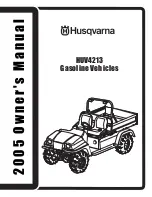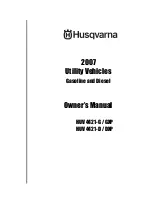
2
•
Always wear ANSI-approved safety glasses and heavy-duty work gloves during assembly
and use.
Do not wear loose clothing or jewelry which can get caught in moving parts.
•
Store idle equipment.
When not in use, tools and equipment should be stored in a dry location
to inhibit rust. Always lock up tools and equipment, and keep out of reach of children.
•
Use the right tool for the job.
Do not attempt to force small equipment to do the work of larger
industrial equipment. There are certain applications for which this equipment was designed. It will
do the job better and more safely at the capacity for which it was intended. Do not modify this
equipment, and do not use this equipment for a purpose for which it was not intended.
•
Check for damaged parts.
Before using this product, carefully check that it will operate properly
and perform its intended function. Check for damaged parts and any other conditions that may
affect the operation of this product. Replace damaged or worn parts immediately.
•
Do not overreach.
Keep proper footing and balance at all times to prevent tripping, falling, back
injury, etc.
•
DO NOT use this trailer when tired or distracted.
•
Industrial applications must follow OSHA requirements.
SPECIFIC OPERATION WARNINGS
•
Before each use, always examine the trailer for proper tire (Part# A15) condition and air pressure,
loose bolts and nuts, structural cracks, bends and any other condition that may affect its safe
operation. Do not use the Trailer even if minor damage appears.
•
Before each use, always attach the Safety Chain (Part# A14) of the trailer to the towing vehicle.
Make sure the Safety Chain is attached to the towing vehicle with the equal length at each side.
Do not allow the Safety Chain to drag on the ground.
•
Always check to make sure the payload being transported is properly and safely secured in the
trailer.
•
Make sure the towing vehicle is capable of towing this trailer and its payload. Make sure the hitch
on the towing vehicle is capable of towing the Trailer and its payload. The towing capacity of the
hitch is typically stamped on the hitch drawbar.
•
Make sure the hitch coupler (Part# A13) and the vehicle’s Ball Hitch (not included) are of equal
mating size (1-7/8in.) and are rated equal to or greater than the weight of the trailer and its
payload.
•
DO NOT
exceed 55 miles per hour when towing the trailer. Excess speed is a major cause of
vehicle-trailer accidents.
•
The Tail Light Bulbs supplied with this trailer are for a 12 VOLT DC electrical system only. Do not
attempt to power the Light Bulbs with any other type or voltage electrical current.
•
Whenever possible, park the trailers on a flat, level, paved surface and chock both tires to keep
the trailer from accidently moving.
•
Before attempting to fold up the trailer, make sure it is on a flat, level, solid surface and chock
both Tires (Part# A15).
•
Never attempt to fold up the trailer without the help of one or two able assistants.
•
DO NOT
exceed the 700 pound weight capacity.
•
DO NOT
allow anyone to ride in the towed vehicle or on the trailer.
•
DO NOT
transport passengers or heavy cargo inside the vehicle that is being towed.
•
The coupler must be properly secured to the hitch ball.
After assembly and attachment, pull
up and down on the hitch coupler to make sure the hitch ball is snug in the hitch coupler. If the
coupler is not secured properly, it could come loose while the trailer is in motion, causing property
damage, serious personal injury or even death.
•
Make wide turns when towing a loaded trailer, avoiding both sharp turns and U-turns.
Turning too sharply can cause damage to the trailer and/or the tow vehicle.

































